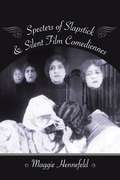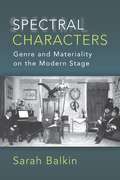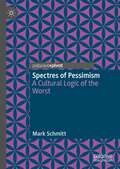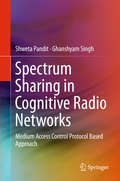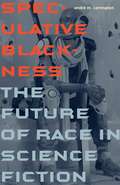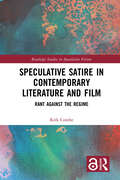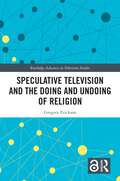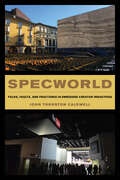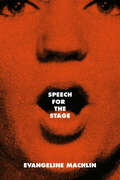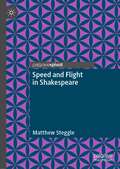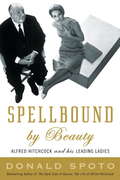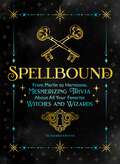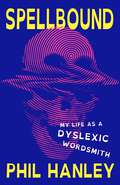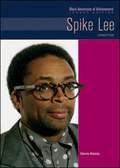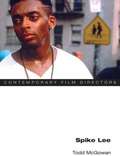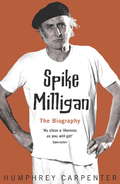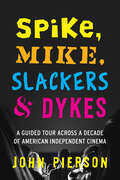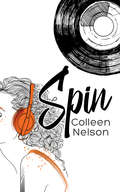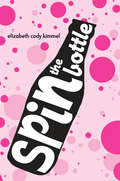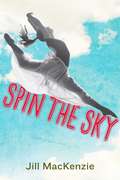- Table View
- List View
Specters of Slapstick and Silent Film Comediennes (Film and Culture Series)
by Maggie HennefeldWomen explode out of chimneys and melt when sprayed with soda water. Feminist activists play practical jokes to lobby for voting rights, while overworked kitchen maids dismember their limbs to finish their chores on time. In early slapstick films with titles such as Saucy Sue, Mary Jane’s Mishap, Jane on Strike, and The Consequences of Feminism, comediennes exhibit the tensions between joyful laughter and gendered violence. Slapstick comedy often celebrates the exaggeration of make-believe injury. Unlike male clowns, however, these comic actresses use slapstick antics as forms of feminist protest. They spontaneously combust while doing housework, disappear and reappear when sexually assaulted, or transform into men by eating magic seeds—and their absurd metamorphoses evoke the real-life predicaments of female identity in a changing modern world.Specters of Slapstick and Silent Film Comediennes reveals the gender politics of comedy and the comedic potentials of feminism through close consideration of hundreds of silent films. As Maggie Hennefeld argues, comedienne catastrophes provide disturbing but suggestive images for comprehending gendered social upheavals in the early twentieth century. At the same time, slapstick comediennes were crucial to the emergence of film language. Women’s flexible physicality offered filmmakers blank slates for experimenting with the visual and social potentials of cinema. Specters of Slapstick and Silent Film Comediennes poses major challenges to the foundations of our ideas about slapstick comedy and film history, showing how this combustible genre blows open age-old debates about laughter, society, and gender politics.
Spectral Characters: Genre and Materiality on the Modern Stage
by Sarah BalkinTheater’s materiality and reliance on human actors has traditionally put it at odds with modernist principles of aesthetic autonomy and depersonalization. Spectral Characters argues that modern dramatists in fact emphasized the extent to which humans are fictional, made and changed by costumes, settings, props, and spoken dialogue. Examining work by Ibsen, Wilde, Strindberg, Genet, Kopit, and Beckett, the book takes up the apparent deadness of characters whose selves are made of other people, whose thoughts become exteriorized communication technologies, and whose bodies merge with walls and furniture. The ghostly, vampiric, and telepathic qualities of these characters, Sarah Balkin argues, mark a new relationship between the material and the imaginary in modern theater. By considering characters whose bodies respond to language, whose attempts to realize their individuality collapse into inanimacy, and who sometimes don’t appear at all, the book posits a new genealogy of modernist drama that emphasizes its continuities with nineteenth-century melodrama and realism.
Spectres of Pessimism: A Cultural Logic of the Worst
by Mark SchmittThis book argues that philosophical pessimism can offer vital impulses for contemporary cultural studies. Pessimist thought offers ways to interrogate notions of temporality, progress and futurity. When the horizon of future expectation is increasingly shaped by the prospect of apocalypse and extinction, an exploration of pessimist thought can help to make sense of an increasingly complex and uncertain world by affirming rather than suppressing the worst. This book argues that a cultural logic of the worst is at work in a substantial section of contemporary philosophical thought and cultural representations.Spectres of pessimism can be found in contemporary ecocritical thought, antinatalist philosophies, political thought, and cultural theory, as well as in literature, film, and popular music. In its unsettling of temporality, this new pessimism shares sensibilities with the field of hauntology. Both deconstruct linear narratives of time that adhere to a stable sequence of past, present and future. Mark Schmitt therefore couples pessimism and hauntology to explore the spectres of pessimism in a range of theories and narratives—from ecocriticism, antinatalism and queer theory to utopianism, from afropessimism to the fiction of Hari Kunzru and Thomas Ligotti to the films of Camille Griffin, Gaspar Noé, Denis Villeneuve and Lars von Trier.
Spectrum Sharing in Cognitive Radio Networks
by Ghanshyam Singh Shweta PanditThis book discusses the use of the spectrum sharing techniques in cognitive radio technology, in order to address the problem of spectrum scarcity for future wireless communications. The authors describe a cognitive radio medium access control (MAC) protocol, with which throughput maximization has been achieved. The discussion also includes use of this MAC protocol for imperfect sensing scenarios and its effect on the performance of cognitive radio systems. The authors also discuss how energy efficiency has been maximized in this system, by applying a simple algorithm for optimizing the transmit power of the cognitive user. The study about the channel fading in the cognitive user and licensed user and power adaption policy in this scenario under peak transmit power and interference power constraint is also present in this book.
Speculative Blackness: The Future of Race in Science Fiction
by André M. CarringtonIn Speculative Blackness, André M. Carrington analyzes the highly racialized genre of speculative fiction—including science fiction, fantasy, and utopian works, along with their fan cultures—to illustrate the relationship between genre conventions in media and the meanings ascribed to blackness in the popular imagination.Carrington&’s argument about authorship, fandom, and race in a genre that has been both marginalized and celebrated offers a black perspective on iconic works of science fiction. He examines the career of actor Nichelle Nichols, who portrayed the character Uhura in the original Star Trek television series and later became a recruiter for NASA, and the spin-off series Star Trek: Deep Space Nine, set on a space station commanded by a black captain. He recovers a pivotal but overlooked moment in 1950s science fiction fandom in which readers and writers of fanzines confronted issues of race by dealing with a fictitious black fan writer and questioning the relevance of race to his ostensible contributions to the 'zines. Carrington mines the productions of Marvel comics and the black-owned comics publisher Milestone Media, particularly the representations of black sexuality in its flagship title, Icon. He also interrogates online fan fiction about black British women in Buffy the Vampire Slayer and the Harry Potter series. Throughout this nuanced analysis, Carrington theorizes the relationship between race and genre in cultural production, revealing new understandings of the significance of blackness in twentieth-century American literature and culture.
Speculative Satire in Contemporary Literature and Film: Rant Against the Regime (Routledge Studies in Speculative Fiction)
by Kirk CombeSince 1980, when neoliberal and neoconservative forces began their hostile takeover of western culture, a new type of political satire has emerged that works to unmask and deter those toxic doctrines. Literary and cultural critic Kirk Combe calls this new form of satire the Rant. The Rant is grim, highly imaginative, and complex in its blending of genres. It mixes facets of satire, science fiction, and monster tale to produce widely consumed spectacles—major studio movies, popular television/streaming series, bestselling novels—designed to disturb and to provoke. The Rant targets what Combe calls the Regime. Simply put, the Regime is the sum of the dangerous social, economic, and political orthodoxies spurred on by neoliberal and neoconservative polity. Such practices include free-market capitalism, corporatism, militarism, religiosity, imperialism, racism, patriarchy, and so on. In the Rant, then, we have a unique and wholly contemporary genre of political expression and protest: speculative satire.
Speculative Satire in Contemporary Literature and Film: Rant Against the Regime (Routledge Studies in Speculative Fiction)
by Kirk CombeSince 1980, when neoliberal and neoconservative forces began their hostile takeover of western culture, a new type of political satire has emerged that works to unmask and deter those toxic doctrines. Literary and cultural critic Kirk Combe calls this new form of satire the Rant. The Rant is grim, highly imaginative, and complex in its blending of genres. It mixes facets of satire, science fiction, and monster tale to produce widely consumed spectacles—major studio movies, popular television/streaming series, bestselling novels—designed to disturb and to provoke. The Rant targets what Combe calls the Regime. Simply put, the Regime is the sum of the dangerous social, economic, and political orthodoxies spurred on by neoliberal and neoconservative polity. Such practices include free-market capitalism, corporatism, militarism, religiosity, imperialism, racism, patriarchy, and so on. In the Rant, then, we have a unique and wholly contemporary genre of political expression and protest: speculative satire.
Speculative Television and the Doing and Undoing of Religion (Routledge Advances in Television Studies)
by Gregory EricksonThis book explores the concept that, as participation in traditional religion declines, the complex and fantastical worlds of speculative television have become the place where theological questions and issues are negotiated, understood, and formed. From bodies, robots, and souls to purgatories and post-apocalyptic scenarios and new forms of digital scripture, the shows examined – from Buffy the Vampire Slayer to Westworld – invite their viewers and fans to engage with and imagine concepts traditionally reserved for religious spaces. Informed by recent trends in both fan studies and religious studies, and with an emphasis on practice as well as belief, the thematically focused narrative posits that it is through the intersections of these shows that we find the reframing and rethinking of religious ideas. This truly interdisciplinary work will resonate with scholars and upper-level students in the areas of religion, television studies, popular culture, fan studies, media studies, and philosophy.
Speculative Television and the Doing and Undoing of Religion (Routledge Advances in Television Studies)
by Gregory EricksonThis book explores the concept that, as participation in traditional religion declines, the complex and fantastical worlds of speculative television have become the place where theological questions and issues are negotiated, understood, and formed.From bodies, robots, and souls to purgatories and post-apocalyptic scenarios and new forms of digital scripture, the shows examined – from Buffy the Vampire Slayer to Westworld – invite their viewers and fans to engage with and imagine concepts traditionally reserved for religious spaces. Informed by recent trends in both fan studies and religious studies, and with an emphasis on practice as well as belief, the thematically focused narrative posits that it is through the intersections of these shows that we find the reframing and rethinking of religious ideas.This truly interdisciplinary work will resonate with scholars and upper-level students in the areas of religion, television studies, popular culture, fan studies, media studies, and philosophy.The Open Access version of this book, available at http://www.taylorfrancis.com, has been made available under a Creative Commons [Attribution-Non Commercial-No Derivatives (CC-BY-NC-ND)] 4.0 license.
Specworld: Folds, Faults, and Fractures in Embedded Creator Industries
by John Thornton CaldwellJohn Thornton Caldwell’s landmark Specworld demonstrates how twenty-first-century media industries monetize and industrialize creative labor at all levels of production. Through illuminating case studies and rich ethnography of colliding social-media and filmmaking practices, Caldwell takes readers into the world of production workshopping and trade mentoring to show media production as an untidy social construct rather than a unified, stable practice. This messy complex system, he argues, is full of discrete yet interconnected parts that include legacy production companies, marketers and influencers, aspirant online producers, data miners, financiers, talent agencies, and more. Caldwell peels away the layers of these embedded production systems to examine the folds, fault lines, and fractures that underlie a risky, high-pressure, and often exploitative industry. With insights on the ethical and human predicament faced by industry hopefuls and crossover creators seeking professional careers, Caldwell offers new interpretive frames and research methods that allow readers to better see the hidden and multifaceted financial logics and forms of labor embedded in contemporary media production industries.
Speech for the Stage
by Evangeline MachlinFrom its original publication, thousands of actors have used this classic text to develop and refine their voice and speech. Evangeline Machlin includes warm-up routines for the voice but initially focuses on the importance of listening. She also discusses such important elements as relaxation, phonetics, articulation, resonance, pitch, rate of speech and stress. In addition, there are chapters on dialects, on reading aloud, sight reading, auditioning and performance.
Speed and Flight in Shakespeare
by Matthew SteggleShakespeare's plays are fascinated by the problems of speed and flight. They are repeatedly interested in humans, spirits, and objects that move very fast; become airborne; and in some cases even travel into space. In Speed and Flight in Shakespeare, the first study of any kind on the subject, Steggle looks at how Shakespeare’s language explores ideas of speed and flight, and what theatrical resources his plays use to represent these states. Shakespeare has, this book argues, an aesthetic of speed and flight. Featuring chapters on The Comedy of Errors, A Midsummer Night’s Dream, Romeo and Juliet, Henry V, Macbeth and The Tempest, this study opens up a new field around the ‘historical phenomenology’ of early modern speed.
Spellbound by Beauty: Alfred Hitchcock and His Leading Ladies
by Donald SpotoSpellbound by Beauty examines Alfred Hitchcock's well known collaborations with the leading ladies of his day, and, in so doing, delves into his creative life and his uniquely curious professional and personal relationships. The result is a singular kind of life story u a book about film and film stars; business and power; sex and fantasy; romance and derailed psychology. Drawing on explosive, never-before-published material and details gleaned through his friendship with Hitchcock, along with archival material and personal collections only recently made available, Donald Spoto casts a new light on this most famous of directors. He traces Hitchcock's professional and social rise and deals frankly with his strange marriage to Alma Reville, his distance from his daughter, Patricia, and his obsessive relationships with a number of his leading ladies from Grace Kelly and Kim Novak to Tippi Hedren.
Spellbound: From Merlin to Hermione, Mesmerizing Trivia About All Your Favorite Witches and Wizards
by Winifred Owens1,001 beguiling facts for fans of witchcraft and wizardryConjure the secrets of your favorite magical tales with Spellbound. This charming trivia compendium is brimming with captivating facts, sneaky Easter eggs, and illuminating behind-the-scenes moments from mystical literature, games, comics, TV, and movies. Discover the Grimm inspiration behind Disney’s fairy tales, the tequila-soaked secrets of Practical Magic, the real magic of Hocus Pocus, the ties that bind Sabrinas, the dramatic origin story of Dungeons & Dragons, and so much more. As you trace magic through time and cultures, you may even find new champions of enchantment to admire.- Unveil 1,001 dazzling details about the sorcerers and enchantresses of legend, literature, and modern media- Celebrate fantastical characters across pop culture, from wicked witches and weary wizards to benevolent spellcasters and magical creatures- Explore insights into the magical writers, actors, and creators who have bewitched us al
Spellbound: My Life as a Dyslexic Wordsmith
by Phil HanleyAn Amazon Best of Biography/MemoirComedian and severe dyslexic Phil Hanley reveals his unlikely path to success in a story that is equal parts hilarious and heartbreaking.When Phil Hanley was in first grade, he realized something that would forever set him apart from his peers: he couldn’t read. His teachers were ill-equipped to assist him, and he slipped through the school’s cracks, year by year falling further and further behind his friends. Finally, he was diagnosed with dyslexia, a learning disability that would shape the rest of his life.Unable to pursue college or a traditional job, Phil was thrust into a life defined by unconventional twists, including a stint as a runway model in Europe. Eventually, he found himself on a stage with a microphone, a spotlight, and five minutes of jokes. Unlike so many previous pursuits, stand-up felt right to Phil, and he soon discovered that the more he worked at it, the more he got out of it—a realization that, he compellingly argues, saved his life. Spellbound is a story of humor and also of struggle and heartbreak, of constantly living in a world that sees things differently than you do, and of triumph over adversity.Phil shows us that dyslexia can be a huge challenge, but it doesn’t spell certain condemnation (and neither can he). Just the opposite: dyslexia has been more than a blessing in his life—it’s been his North Star.
Spike Lee (Black Americans of Achievement--Legacy Edition)
by Dennis AbramsIn his own words, Spike Lee is the man who single-handedly "broke the color barrier" in Hollywood in the mid 1980s. In a film career that spans more than 20 years, Lee has established himself as one of the United States' premier filmmakers, a director whose films explore the many aspects of the African-American experience. Never one to shy away from controversy--he has been accused of racism, anti-Semitism, and sexism--Lee uses film to raise tough questions and to provoke discussion. How was he able to break down the doors of Hollywood for himself and for other African-American directors, actors, and technicians? How has he continued to grow and develop as a filmmaker? Spike Lee presents a nuanced portrait of an artist who has become a symbol of contemporary American culture.
Spike Lee (Contemporary Film Directors)
by Todd McGowanSince the release of Do the Right Thing in 1989, Spike Lee has established himself as a cinematic icon. Lee's mostly independent films garner popular audiences while at the same time engaging in substantial political and social commentary. He is arguably the most accomplished African American filmmaker in cinematic history, and his breakthrough paved the way for the success of many other African Americans in film. In this first single-author scholarly examination of Spike Lee's oeuvre, Todd McGowan shows how Lee's films, from She's Gotta Have It through Red Hook Summer, address crucial social issues such as racism, paranoia, and economic exploitation in a formally inventive manner. McGowan argues that Lee uses excess in his films to intervene in issues of philosophy, politics, and art. McGowan contends that it is impossible to watch a Spike Lee film in the way that one watches a typical Hollywood film. By forcing observers to recognize their unconscious enjoyment of violence, paranoia, racism, sexism, and oppression, Lee's films prod spectators to see differently and to confront their own excess. In the process, his films reveal what is at stake in desire, interpersonal relations, work, and artistic creation itself.
Spike Lee: On His Own Terms
by Melissa McdanielSpike Lee is one of the most popular and innovative filmmakers working today. With films such as She's Gotta Have It, Do the Right Thing, and Malcolm X, Spike Lee has explored complex issues in a style that is both entertaining, challenging, and fun.
Spike Milligan
by Humphrey CarpenterSpike Milligan was one of our best-loved comics as well as one of our most original. In this first major assessment of Spike's life and career, the highly respected biographer Humphrey Carpenter has - through copious research and access to many of those closest to the great man - unearthed a character who could be as difficult and contradictory as he was generous and talented.The creator of The Goons was to influence a whole generation of comics, yet was never to feel fully valued. His periods of depression were matched by periods of high creativity - there were poems, novels, volumes of biography, as well as TV series and a one-man show as Spike searched for his best means of expression. There was also, as revealed here, his inveterate womanising. Married three times and with four children to whom he was devoted, two illegitimate children were to remain barely acknowledged,Detailing both his private and professional life, Humphrey Carpenter gives us the most revealing portrait yet of this highly complex genius.
Spike Milligan
by Humphrey CarpenterSpike Milligan was one of our best-loved comics as well as one of our most original. In this first major assessment of Spike's life and career, the highly respected biographer Humphrey Carpenter has - through copious research and access to many of those closest to the great man - unearthed a character who could be as difficult and contradictory as he was generous and talented.The creator of The Goons was to influence a whole generation of comics, yet was never to feel fully valued. His periods of depression were matched by periods of high creativity - there were poems, novels, volumes of biography, as well as TV series and a one-man show as Spike searched for his best means of expression. There was also, as revealed here, his inveterate womanising. Married three times and with four children to whom he was devoted, two illegitimate children were to remain barely acknowledged,Detailing both his private and professional life, Humphrey Carpenter gives us the most revealing portrait yet of this highly complex genius.
Spike, Mike, Slackers & Dykes: A Guided Tour Across a Decade of American Independent Cinema
by John Pierson&“A fast-moving account of the era bookended by Stranger Than Paradise and Pulp Fiction . . . [a] Baedeker of off-Hollywood where all roads lead to Park City.&” —Interview The legendary figure who launched the careers of Spike Lee, Michael Moore, and Richard Linklater offers a no-holds-barred look at the deals and details that propel an indie film from a dream to distribution. At the epicenter of the industry in the 1980s and &’90s, John Pierson reveals what it took to launch such films as Stranger Than Paradise, Clerks, She&’s Gotta Have It, and Roger and Me. A chronicle of a remarkable decade for the American independent low-budget film, Spike, Mike, Slackers & Dykes also celebrates the nearly two dozen first-time filmmakers whom Pierson helped make a name for themselves and the hundred others whose success stories he observed at close quarters. &“John Pierson has faithfully chronicled the American independent scene. He was there, he knows.&” —Spike Lee &“Sly, knowledgeable, deeply entertaining . . . You couldn&’t do much better than to hop aboard this ten-year wild ride. Grade: A.&” —Entertainment Weekly &“The most contentiously witty and revealing view of off-Hollywood around.&” —Rolling Stone &“Mr. Pierson, who has lived, breathed, and hunted film for most of his adult life, covers his territory with urgency and conviction, and his single-mindedness is ravishing.&” —The New York Times Book Review &“Pierson&’s prose is quick-moving and witty and reads like a Who&’s Who of the off-Hollywood mavericks who make the movies we&’d like to see but can&’t always find.&” —The Washington Post &“A marvelously entertaining, educational, and caustic account of the rise of American independent filmmaking.&” —The Globe and Mail
Spike, Mike, Slackers & Dykes: A Guided Tour Across a Decade of American Independent Cinema
by John Pierson&“A fast-moving account of the era bookended by Stranger Than Paradise and Pulp Fiction . . . [a] Baedeker of off-Hollywood where all roads lead to Park City.&” —Interview The legendary figure who launched the careers of Spike Lee, Michael Moore, and Richard Linklater offers a no-holds-barred look at the deals and details that propel an indie film from a dream to distribution. At the epicenter of the industry in the 1980s and &’90s, John Pierson reveals what it took to launch such films as Stranger Than Paradise, Clerks, She&’s Gotta Have It, and Roger and Me. A chronicle of a remarkable decade for the American independent low-budget film, Spike, Mike, Slackers & Dykes also celebrates the nearly two dozen first-time filmmakers whom Pierson helped make a name for themselves and the hundred others whose success stories he observed at close quarters. &“John Pierson has faithfully chronicled the American independent scene. He was there, he knows.&” —Spike Lee &“Sly, knowledgeable, deeply entertaining . . . You couldn&’t do much better than to hop aboard this ten-year wild ride. Grade: A.&” —Entertainment Weekly &“The most contentiously witty and revealing view of off-Hollywood around.&” —Rolling Stone &“Mr. Pierson, who has lived, breathed, and hunted film for most of his adult life, covers his territory with urgency and conviction, and his single-mindedness is ravishing.&” —The New York Times Book Review &“Pierson&’s prose is quick-moving and witty and reads like a Who&’s Who of the off-Hollywood mavericks who make the movies we&’d like to see but can&’t always find.&” —The Washington Post &“A marvelously entertaining, educational, and caustic account of the rise of American independent filmmaking.&” —The Globe and Mail
Spin
by Colleen NelsonAn aspiring teenage DJ must learn how to navigate life when people find out that she's the daughter of a famous singer. Fifteen-year-old Delilah “Dizzy” Doucette lives with her dad and brother above their vintage record store, The Vinyl Trap. She’s learning how to spin records from her brother’s best friend, and she’s getting pretty good. But behind her bohemian life, Dizzy and her family have a secret: her mom is the megafamous singer Georgia Waters. When this secret is revealed to the world, Dizzy’s life spins out of control. She must decide what is most important to her — the family she has or the family she wants.
Spin The Bottle
by Elizabeth Cody KimmelMiddle school is an Entirely New Planet. The girls look fully grown in the most glamorous and complicated ways, and the boys look... well, weird. The good news? Drama Club. Real Drama Club -- with actual auditions, and roles involving more than the days of the week. Phoebe Hart has waited a long time for this. The stage, after all, is the one place the "flawed and unremarkable" Phoebe can let her inner star out. But when she learns of the opening night tradition?a game of Spin the Bottle?things suddenly get way more complicated. Enter: a heart-stopping crush, a best friend who might not be, two bloodthirsty Drama Divas, and a certain spinning bottle. Is it worth all the drama for a girl who just wants to fit in, and maybe prove her acting chops along the way? Welcome to middle school, Phoebe Hart....
Spin the Sky
by Jill MackenzieMagnolia Woodson wants nothing more than to get her and her sister, Rose, out of the pitifully small, clamming-obsessed Oregon town that hates them-she just doesn't know how. Forced to put up with the snide comments and hateful looks the townspeople throw at them, Mags thinks she's destined to pay for the horrible, awful thing her mom did-and that she's left her and Rose to deal with-until the day she dies.But when a nationwide televised dance competition posts tryouts in nearby Portland, Mags's best friend, George, says they have to go and audition. Not only have they spent the past fourteen years of their lives dancing side-by-side, dreaming of a day just like this, but also it could be Mags's chance of a lifetime-a chance to win the grand-prize money and get her and Rose out of Summerland, a chance to do the thing she loves most with everyone watching, a chance to show the town that she's not-and has never been-a "no-good Woodson girl," like her mother. But will the competition prove too steep? And will Mags be able to retain her friendship with George as they go head-to-head in tryouts? Mags will have to learn that following her dreams may mean changing her life forever.
